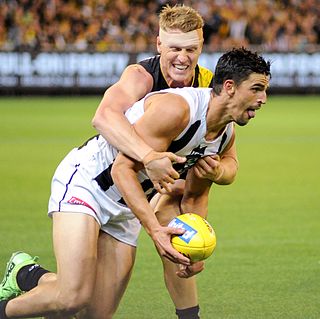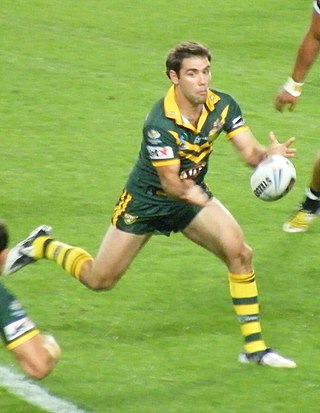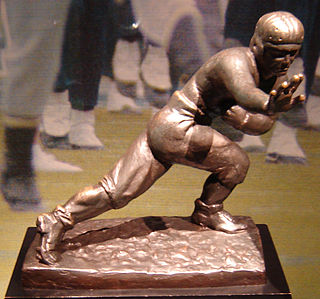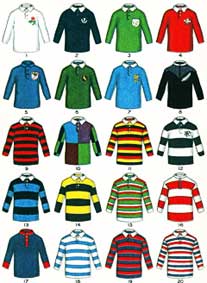An ankle-tap or tap-tackle is a form of tackle used in rugby league, [1] rugby union and gridiron football.
It is used when the player carrying the ball is running at speed and a defending player is approaching from behind or the side. If the defender is not able to get close enough to the ball-carrier to wrap his arms around him in a conventional tackle, he may still be able to dive at the other player's feet and, with an outstretched arm, deliver a tap or hook to the player's foot or ankle, causing the player to stumble. At speed, this will often be sufficient to bring the ball-carrier down.

Most forms of football have a move known as a tackle. The primary purposes of tackling are to dispossess an opponent of the ball, to stop the player from gaining ground towards goal or to stop them from carrying out what they intend.

In gridiron football, a lineman is a player who specializes in play at the line of scrimmage. The linemen of the team currently in possession of the ball are the offensive line, while linemen on the opposing team are the defensive line. A number of NFL rules specifically address restrictions and requirements for the offensive line, whose job is to help protect the quarterback from getting sacked for a loss, or worse, fumbling. The defensive line is covered by the same rules that apply to all defensive players. Linemen are usually the largest players on the field in both height and weight, since their positions usually require less running and more strength than skill positions.
In rugby football, the penalty is the main disciplinary sanction available to the referee to penalise players who commit deliberate infringements. The team who did not commit the infringement are given possession of the ball and may either kick it towards touch, attempt a place kick at goal, or tap the ball with their foot and run it. It is also sometimes used as shorthand for penalty goal.
A rugby league team consists of thirteen players on the field, with 4 substitutes on the bench. Each of the thirteen players is assigned a position, normally with a standardised number, which reflects their role in attack and defence, although players can take up any position at any time.

Touch rugby refers to games derived from rugby football in which players do not tackle each other but instead touch their opponents using their hands on any part of the body, clothing, or the ball.

Like most forms of modern football, rugby league football is played outdoors on a rectangular grass field with goals at each end that are to be attacked and defended by two opposing teams. The rules of rugby league have changed significantly over the decades since rugby football split into the league and union codes. This article details the modern form of the game and how it is generally played today, however rules do vary slightly between specific competitions.

A comparison of American football and rugby union is possible because of the games' shared origins, despite their dissimilarities.

The team sports rugby union and rugby league have shared origins and thus many similarities.

Rugby union is a contact sport that consists of two teams of fifteen players. The objective is to obtain more points than the opposition through scoring tries or kicking goals over eighty minutes of playing time. The play is started with one team drop-kicking the ball from the halfway line towards the opposition. The rugby ball can be moved up the field by either carrying it or kicking it. However, when passing the ball it can only be thrown laterally or backward. The opposition can stop players moving up the field by tackling them. Only players carrying the ball can be tackled and once a tackle is completed the opposition can compete for the ball. Play continues until a try is scored, the ball crosses the side line or dead-ball line, or an infringement occurs. After a team scores points, the non-scoring team restarts the game at the halfway with a drop kick toward the opposition. The team with the most points at the end wins the game.
A grapple tackle is a controversial tackling technique used in rugby league. It has gained notoriety in Australia's National Rugby League competition whereby the tackler attempts to impede the ball carrier by applying a chokehold-like grip. Although players can be penalised for its use, it is difficult to enforce.
This is a general glossary of the terminology used in the sport of rugby union. Where words in a sentence are also defined elsewhere in this article, they appear in italics.

The stiff-arm fend is a tactic employed by the ball-carrier in many forms of contact football.
The sport of rugby league football has accrued a considerable amount of jargon to describe aspects of the game. Many terms originate from the Laws of the Game. A number of aspects of the game have more than one term that refers to them. Different terms have become popularly used to describe an aspect of the game in different places with notable differences between the northern and southern hemispheres.

Flanker is a position in the sport of rugby union. Each team of 15 players includes two flankers, who play in the forwards, and are generally classified as either blindside or openside flankers, numbers 6 and 7 respectively. The name comes from their position in a scrum in which they 'flank' each set of forwards. They compete for the ball – most commonly in rucks and mauls. Flankers also assist in pushing in a scrum, but are expected to detach from the scrum as soon as the ball is out to get to the play before the opposition's forwards. Flankers also participate in line-outs, either being lifted to contest or win possession, or to lift other players. Flankers are usually the key participants in the tackling process. The flankers, especially the openside, are often the fastest forwards on the team but still relied upon for tackling.

A traditional rugby union kit consists of a jersey and shorts, long rugby socks and boots with studs. The other main piece of equipment is the rugby ball.
A “one-on-one tackle” is a play and term in rugby league football in which a single defender attempts to tackle the ball carrier. It is the only situation in which the defending player is permitted to attempt to dispossess the ball carrier. If the tackler completes the tackle or a defending team-mate joins the tackle attempt, the ball may no longer be legally stolen from the ball carrier's grasp, and a defender attempting to do so is liable to be penalised. The Note for Law 11, Section 9 states: Where a player steals the ball from a player on whom he is effecting a tackle, play will be allowed to continue. Where two or more players are effecting the same tackle - irrespective of whether all but one “drops off” the tackle, and the ball is subsequently taken from the tackled player, a penalty will be awarded against the player or players effecting the tackle.
A penalty in rugby union is the main disciplinary sanction available to the referee to penalise a team who commit deliberate infringements. The team who did not commit the infringement are given possession of the ball and they may either kick it towards touch, attempt a place kick at goal, or tap the ball with their foot and run. It is also sometimes used as shorthand for penalty goal.
A comparison of Canadian football and rugby union is possible because of the games' shared origins, despite their dissimilarities.
In rugby league football, the Laws of the Game are the rules governing how the sport is played. The Laws are the responsibility of the Rugby League International Federation, and cover the play, officiating, equipment and procedures of the game.

The laws of Rugby Union are defined by World Rugby and dictate how the game should be played. They are enforced by a referee, generally with the help of two assistant referees.